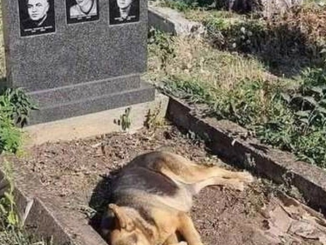
“An Incredible Tale of Survival: Man’s Best Friend Comes to the Rescue

In the breathtaking peaks of Croatia’s Velebit mountain range, Grga Brkić faced a life-threatening situation. While hiking on one of the highest peaks, he tragically fell 500 feet, fracturing his leg, rendering him immobile, and staring death in the face.
There’s a profound love that dogs have for us, a love that knows no bounds. One man who experienced this love firsthand is Grga Brkić. As he lay stranded in the freezing cold, with hypothermia creeping in, hope arrived in the form of his loyal companion, North—an eight-month-old Alaskan Malamute.
North, instinctively understanding the dire circumstances, climbed atop his injured owner, providing warmth and comfort until help could reach them. This harrowing incident unfolded approximately 5,800 feet above Croatia’s Adriatic coastline, as reported by PEOPLE.

Brkić’s fall left him with a fractured lower leg and the inability to move. Two fellow hikers discovered him and his faithful dog at the base of the slope, realizing the impossibility of lifting him out on their own. They immediately called for rescuers.
In an incredible display of loyalty, North nestled beside Brkić, sharing his body heat to keep him warm. Alaskan Malamutes are known for their remarkable cold tolerance, capable of withstanding temperatures as low as -20°F, thanks to their thick, waterproof double coats designed for the harsh Arctic conditions.

For 13 grueling hours, Brkić clung to hope, knowing that North was his lifeline. Finally, a team of 27 first responders from the Croatian emergency mountaineers, Hrvatska Gorska Služba Spašavanja, arrived on the scene, and their astonishment was palpable. North had steadfastly curled around Brkić, providing vital warmth throughout the ordeal.
The rescue mission faced daunting challenges—snow, ice, and fallen trees—making it one of the most demanding operations ever undertaken by these seasoned professionals. Remarkably, North never left Brkić’s side.
Ultimately, they were airlifted to a nearby hospital, where Brkić underwent a lifesaving emergency operation, making a full recovery. Thankfully, North emerged from the incident unscathed.
Josip Brozičević, the head of the Croatian mountain rescue services, praised North’s heroic actions, stating, “The dog was curled up next to the owner in the pit the entire time; he warmed his owner with his body, thus preventing the mountaineer’s significant hypothermia who suffered a severe fracture of the lower leg and ankle when he fell.”

In a heartfelt interview with Croatian media, Brkić expressed his gratitude, acknowledging that he wouldn’t be alive today if it weren’t for North. The moments before rescue arrived felt agonizingly slow, but North’s presence was a true miracle.
Following the incident, the Croatian emergency mountaineers posted about the incredible rescue, and Brkić’s family shared an update, confirming that both he and North were doing remarkably well.
This extraordinary tale is a testament to the indomitable spirit of friendship between humans and their loyal canine companions. Share this story to celebrate the extraordinary bond between Grga Brkić and North and to honor the incredible bravery of our furry friends.
In the breathtaking peaks of Croatia’s Velebit mountain range, Grga Brkić faced a life-threatening situation. While hiking on one of the highest peaks, he tragically fell 500 feet, fracturing his leg, rendering him immobile, and staring death in the face.
There’s a profound love that dogs have for us, a love that knows no bounds. One man who experienced this love firsthand is Grga Brkić. As he lay stranded in the freezing cold, with hypothermia creeping in, hope arrived in the form of his loyal companion, North—an eight-month-old Alaskan Malamute.
North, instinctively understanding the dire circumstances, climbed atop his injured owner, providing warmth and comfort until help could reach them. This harrowing incident unfolded approximately 5,800 feet above Croatia’s Adriatic coastline, as reported by PEOPLE.
Brkić’s fall left him with a fractured lower leg and the inability to move. Two fellow hikers discovered him and his faithful dog at the base of the slope, realizing the impossibility of lifting him out on their own. They immediately called for rescuers.
In an incredible display of loyalty, North nestled beside Brkić, sharing his body heat to keep him warm. Alaskan Malamutes are known for their remarkable cold tolerance, capable of withstanding temperatures as low as -20°F, thanks to their thick, waterproof double coats designed for the harsh Arctic conditions.
For 13 grueling hours, Brkić clung to hope, knowing that North was his lifeline. Finally, a team of 27 first responders from the Croatian emergency mountaineers, Hrvatska Gorska Služba Spašavanja, arrived on the scene, and their astonishment was palpable. North had steadfastly curled around Brkić, providing vital warmth throughout the ordeal.
The rescue mission faced daunting challenges—snow, ice, and fallen trees—making it one of the most demanding operations ever undertaken by these seasoned professionals. Remarkably, North never left Brkić’s side.
Ultimately, they were airlifted to a nearby hospital, where Brkić underwent a lifesaving emergency operation, making a full recovery. Thankfully, North emerged from the incident unscathed.
Josip Brozičević, the head of the Croatian mountain rescue services, praised North’s heroic actions, stating, “The dog was curled up next to the owner in the pit the entire time; he warmed his owner with his body, thus preventing the mountaineer’s significant hypothermia who suffered a severe fracture of the lower leg and ankle when he fell.”
In a heartfelt interview with Croatian media, Brkić expressed his gratitude, acknowledging that he wouldn’t be alive today if it weren’t for North. The moments before rescue arrived felt agonizingly slow, but North’s presence was a true miracle.
Following the incident, the Croatian emergency mountaineers posted about the incredible rescue, and Brkić’s family shared an update, confirming that both he and North were doing remarkably well.
This extraordinary tale is a testament to the indomitable spirit of friendship between humans and their loyal canine companions. Share this story to celebrate the extraordinary bond between Grga Brkić and North and to honor the incredible bravery of our furry friends.
“A Cop’s Compassion: Abandoned Dog’s Tearful Plea Earns a Forever Home”
In the quiet solitude of a deserted street, a small puppy sat forlorn and motionless, embodying a sense of despair that tugged at the heartstrings of anyone who chanced upon its gaze. Tear-filled eyes spoke volumes of the dog’s plight, abandoned and forgotten, left with nowhere to call home. With a heart heavy with desolation, the dog’s only glimmer of hope was to approach a nearby police base, a silent plea for assistance echoing in its every step.

The dog’s destiny hung in the balance, unsure if anyone would heed its silent cries. Yet, propelled by necessity, the pup summoned its courage and approached the door of the police base. As fate would have it, a compassionate policeman stood close by, his attention drawn to the faint knocking. Opening the door, he was met with a heart-rending sight: a little dog, its eyes filled with a poignant mixture of vulnerability and supplication. In that instant, the policeman’s heart melted, swayed by the dog’s touching plea for help. Gently, he inquired, “What brings you here, little one?” In response, the dog mustered a tentative wag of its tail, eyes gleaming with a glimmer of hope. With resolve solidified, the officer scooped up the trembling pup, ushering it into the safety of the police base.

From that moment on, a transformation took place — one that would shape the destiny of both the dog and its newfound protector. The puppy found itself embraced by the warm embrace of the police base, quickly endearing itself to the officers within. Its loyalty and affection became apparent, igniting a genuine bond that resonated throughout the base’s corridors. The dog’s presence became a source of solace and camaraderie, a reminder of the remarkable ability of animals to forge connections that transcend words.

With each passing day, the dog’s life underwent a remarkable metamorphosis. It was given a new name: Lucky, embodying the newfound fortune that had smiled upon it. Lucky’s once desolate existence now blossomed into a life brimming with love, care, and companionship. It proved itself as a faithful and devoted companion, a steadfast friend to those who had taken it in.
Lucky’s story is a testament to the power of compassion and the profound impact that even a small gesture of kindness can have on a life. It serves as a reminder that amid the challenges of the world, there is always room for humanity to shine through. The bond between Lucky and the police officers is a symbol of the unwavering devotion that animals bring into our lives, and the reciprocal love that can flourish when we extend a helping hand.

In conclusion, the heartwarming tale of Lucky, the abandoned dog who found solace within the embrace of a police base, resonates as a testament to the resilience of animals and the boundless capacity of humans to show compassion. Lucky’s journey from despair to hope serves as an inspiration, underscoring the importance of extending empathy to the voiceless and reminding us that every act of kindness creates ripples of positivity that enrich lives in unimaginable ways.



Leave a Reply